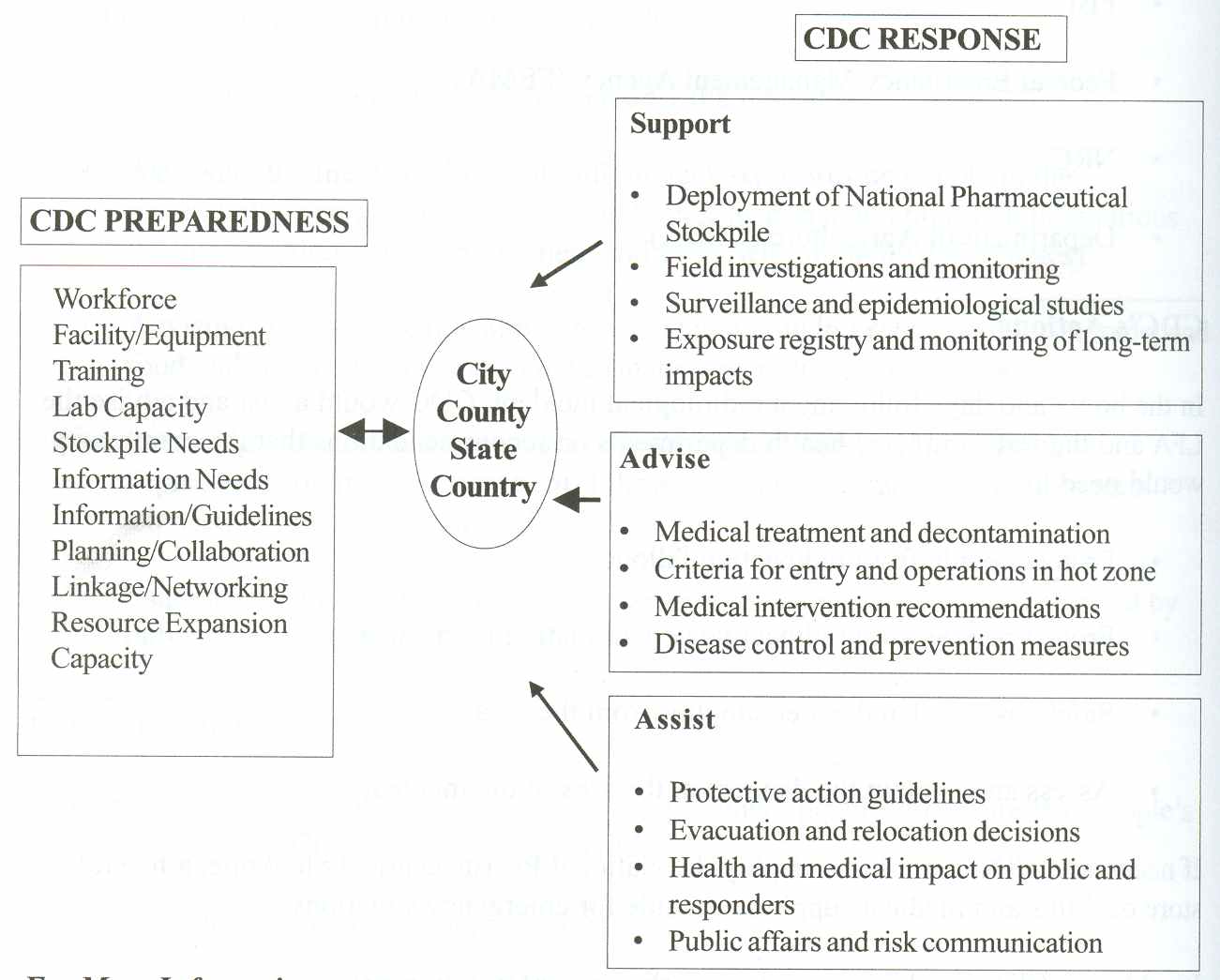
v CDCís Roles in the Event of a Radiological Terrorist Event
Because of recent terrorist events, people may be concerned about the possibility of a terrorist attack involving radioactive materials. People may wonder what the Centers for Disease Control and Prevention (CDC) would do to protect peopleís health if such an event were to occur. CDC has prepared this fact sheet to help people understand the roles and responsibilities of CDC during such an incident.
Lead Federal Agencies
In the event of a radiological accident or terrorist attack, the agency that is responsible for the site of the incident also has responsibility for responding to the emergency and protecting the people, property, and environment around the area. For example, if the incident occurs on property owned by the federal government, such as a military base, research facility, or nuclear facility, then the federal government takes responsibility. In areas that are not controlled by the federal government, the state and local governments have the responsibility to respond to the emergency and protect people, property, and the environment.
Regardless of whether the state, local, or federal government is responsible for responding to the emergency, a federal agency would be sent to the terrorist incident site and would act as the Lead Federal Agency (LFA). This agency would work with the state and local government and might be the Nuclear Regulatory Commission (NRC), the Federal Bureau of Investigation (FBI), or another agency depending on what type of incident occurred (accidental or intentional release of radioactive materials) and where it occurred (nuclear power plant versus a spilled radioactive material in an urban or suburban area). The LFA would implement the Federal Radiological Emergency Response Plan (FRERP); within this plan, the Department of Health and Human Services (HHS) has the major role in protecting peopleís health through:
Monitoring, assessing, and following up on peopleís health
Ensuring the safety of workers involved in and responding to the incident
Ensuring that the food supply is safe
Providing medical and public health advice
CDCís Roles
As part of HHS, CDC would be the chief public health entity to respond to a radiological incident, whether accidental or intentional. As the chief public health entity, CDCís specific roles and responsibilities would include:
Assessing the health of people affected by the incident
Assessing the medical effects of radiological exposures on people in the community, emergency responders and other workers, and high-risk populations (such as children, pregnant women, and those with immune deficiencies)
Advising state and local health departments on how to protect people, animals, and food and water supplies from contamination by radioactive materials
Providing technical assistance and consultation to state and local health departments on medical treatment, follow-up, and decontamination of victims exposed to radioactive materials
Establishing and maintaining a registry of people exposed to or contaminated by radioactive materials
CDCís Partners
To carry out its roles, CDC would work with many other agencies to ensure that peopleís health is protected. These agencies may include:
State and Local Health Departments
Department of Defense (DoD)
Department of Energy (DOE)
Department of Transportation (DOT)
HHS
o Food and Drug Administration (FDA)
o Agency for Toxic Substances and Disease Registry (ATSDR)
o Office of Emergency Response (OER)
o Health Resources and Services Administration (HRSA)
o Substance Abuse and Mental Health Services Administration (SAMHSA)
Environmental Protection Agency (EPA)
FBI
Federal Emergency Management Agency (FEMA)
NRC
Department of Agriculture (USDA)
CDCís Actions
In the hours and days following a radiological incident, CDC would assist and advise the LFA and the state and local health departments on recommendations that the community would need to:
Protect people from radioactive fallout
Protect people from radioactive contamination in the area
Safely use food and water supplies from the area
Assess and explain the dangers in the area of the incident
If necessary, CDC would also deploy the National Pharmaceutical Stockpile, a federal store of drugs and medical supplies set aside for emergency situations.
In addition, CDC would give workers in the area information on:
The amount of time they can safely work in an area contaminated with radioactive materials
Equipment needed to protect themselves from radiation and radioactive materials
Types of respiratory devices needed to work in the contaminated area
How to use radiation monitoring devices
Radiation Exposure Registry
Following an incident involving radioactive materials, CDC would work with ATSDR to establish an exposure registry. The purpose of this registry would be to monitor peopleís exposure to radiation and perform dose reconstructions to determine the exact amount of radiation to which people were exposed. This registry would help CDC determine the necessary long-term medical follow-up for those who were affected by the incident.

For More Information
See CDCís websites at http://www.cdc.gov, http://www.bt.cdc.gov, and www.bt.cdc.gov/radiation/index.asp.
†
Last updated: December 20, 2002